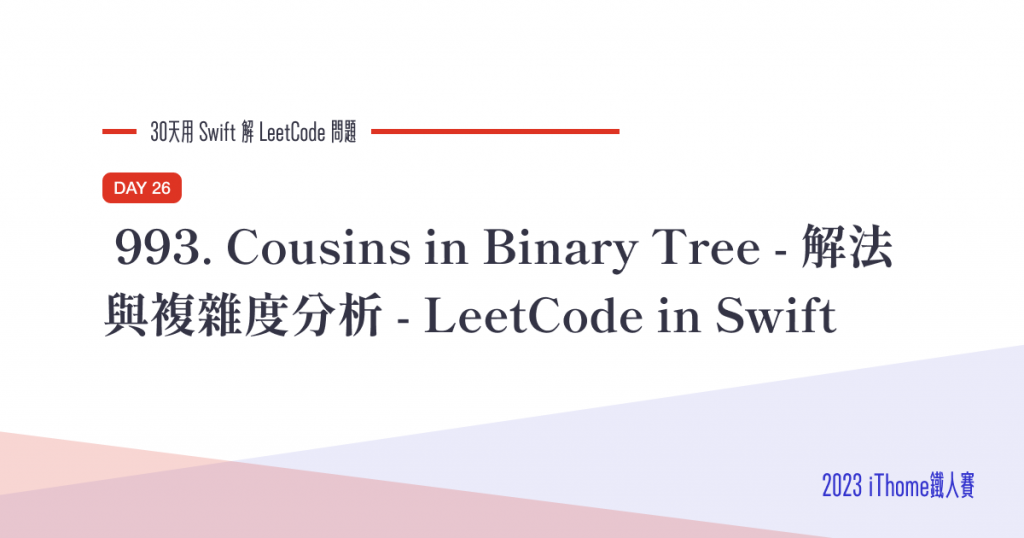
這篇是寫的時候想到的解法,用 backtracking 的方式走訪每一個節點並記錄下每一個節點的資訊:
這題還可以用其他像是 深度優先搜尋 的方式解,程式碼比 backtracking 短。不過這篇就先記錄我自己原先的寫法,之後再另外寫深度優先搜尋的解法。
停止 遞迴的條件,防止無限迴圈。明確標示之下雖然變得有點長,不過自己來說語意上是好理解多了。
在行內有寫更詳細的說明請參照程式碼:
class Solution {
func isCousins(_ root: TreeNode?, _ x: Int, _ y: Int) -> Bool {
// 準備必要的變數
var hashTable = [Int: (depth: Int, parent: Int)]()
var hasX = false
var hasY = false
// 執行 backtracking
find(root, &hashTable, 0, nil, x, y, &hasX, &hasY)
// 根據題目給的條件回傳比較結果
return hashTable[x]?.depth == hashTable[y]?.depth // 條件 1 - 相同深度
&& hashTable[x]?.parent != hashTable[y]?.parent // 條件 2 - 不同父節點
}
/**
Backtracking 用的子處理 (subroutine)
- Parameters:
- root: 想要走訪的節點
- hashTable: 主要儲存的 hashTable
- depth: 當前的深度
- parent: 讓子節點參照的父節點
- x: (提早停止用) 題目給的 x
- y: (提早停止用) 題目給的 y
- hasX: (提早停止用) 標示是否遇到 x 過
- hasY: (提早停止用) 標示是否遇到 y 過
*/
private func find(_ root: TreeNode?, _ hashTable: inout [Int: (depth: Int, parent: Int)], _ depth: Int, _ parent: TreeNode?, _ x: Int, _ y: Int, _ hasX: inout Bool, _ hasY: inout Bool) {
// 停止:遇到空值就停止繼續走訪
guard let root = root else { return }
// 如果有遇到 x 或 y ,就紀錄節點資訊和調整對應的 flag
// 題目有提到節點中的數值不會重複的限制,因此紀錄時可以不用考慮值會被覆蓋掉的情形。
if root.val == x || root.val == y {
hashTable[root.val] = (depth, parent?.val ?? -1)
hasX = root.val == x
hasY = root.val == y
}
// 停止:遇到 x 和 y 都有遇到過的話就停止繼續走訪
if hasX && hasY { return }
// 往下一層走的準備
let newDepth = depth + 1
// 走左節點
find(root.left, &hashTable, newDepth, root, x, y, &hasX, &hasY)
// 走右節點
find(root.right, &hashTable, newDepth, root, x, y, &hasX, &hasY)
}
}
令 n 為節點數
| Big O | 說明 | |
|---|---|---|
| 時間複雜度 | O(n) | 最壞的情形之下全部會個走過一次 |
| 空間複雜度 | O(n) | 用了 hash table 暫存資訊 |
以上,就是今天的 LeetCode in Swift ,
如果有什麼問題和回饋歡迎留言一起討論,今天就到這裡,明天見!
